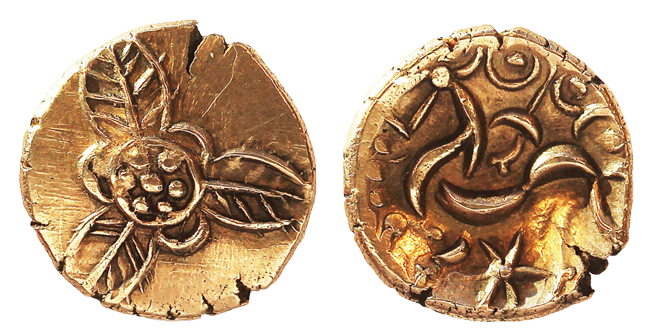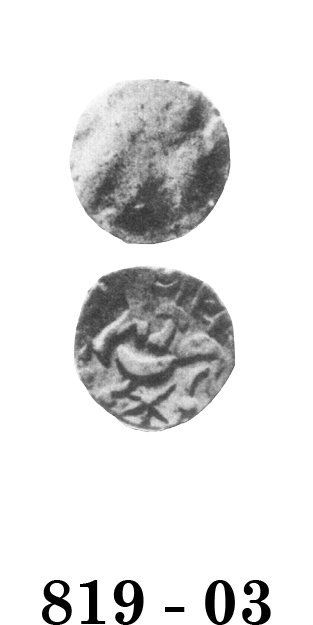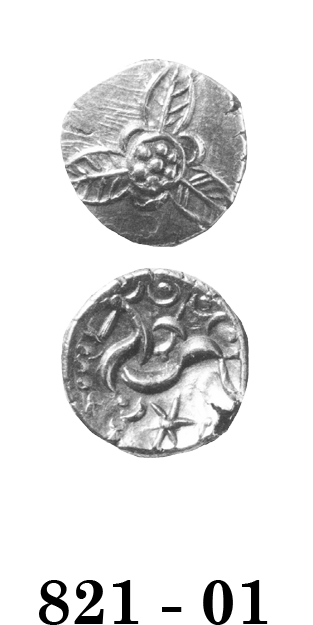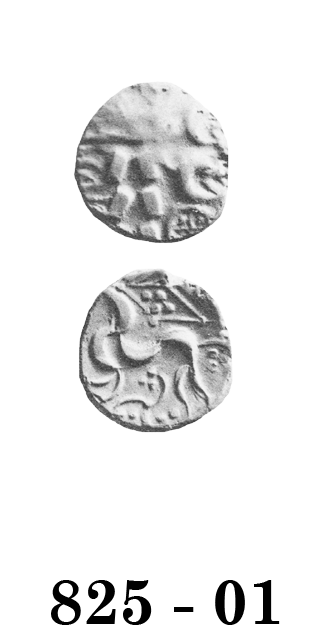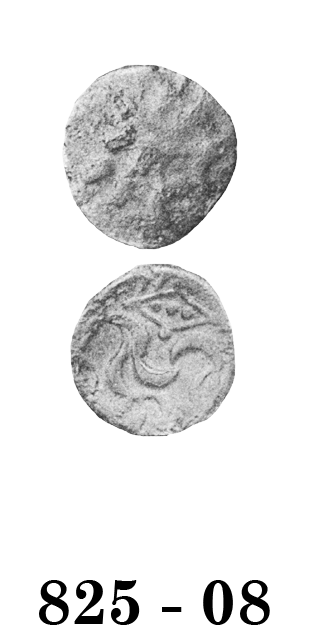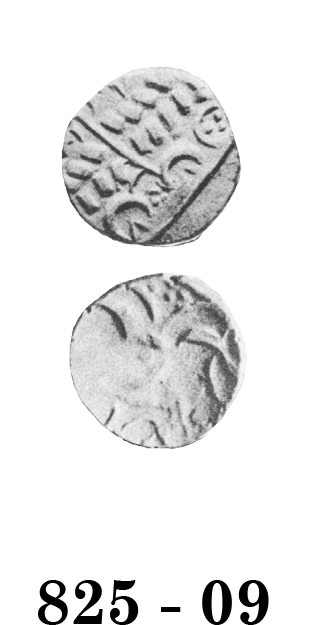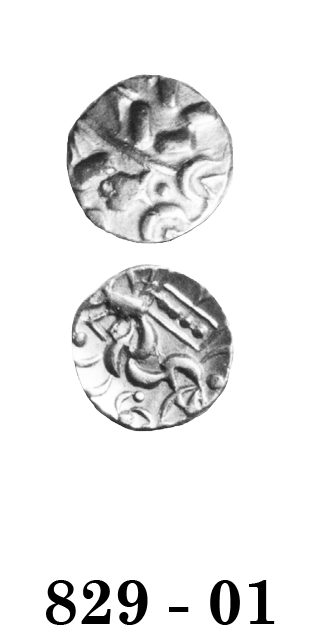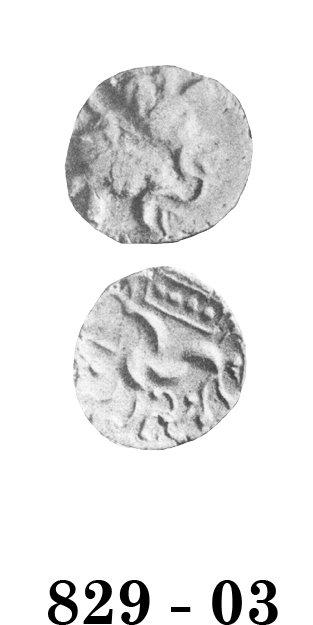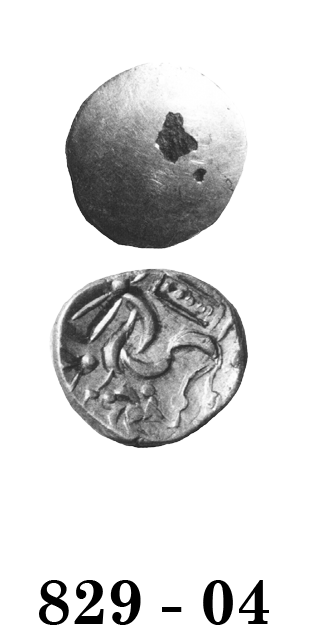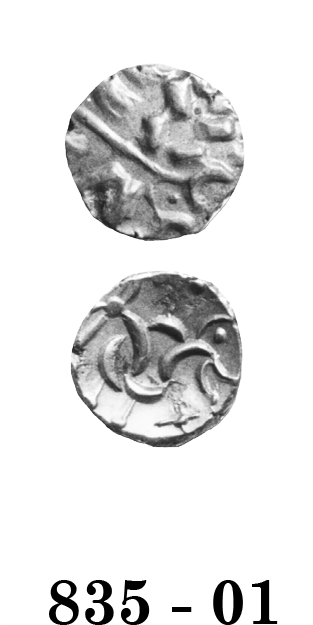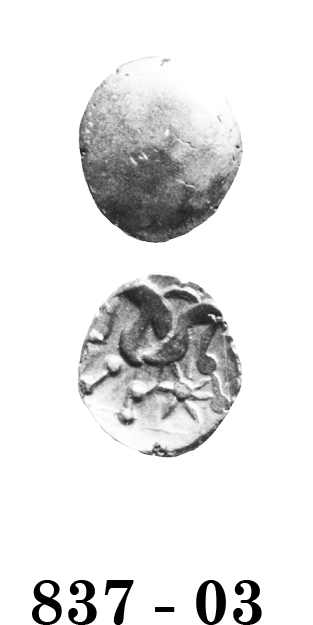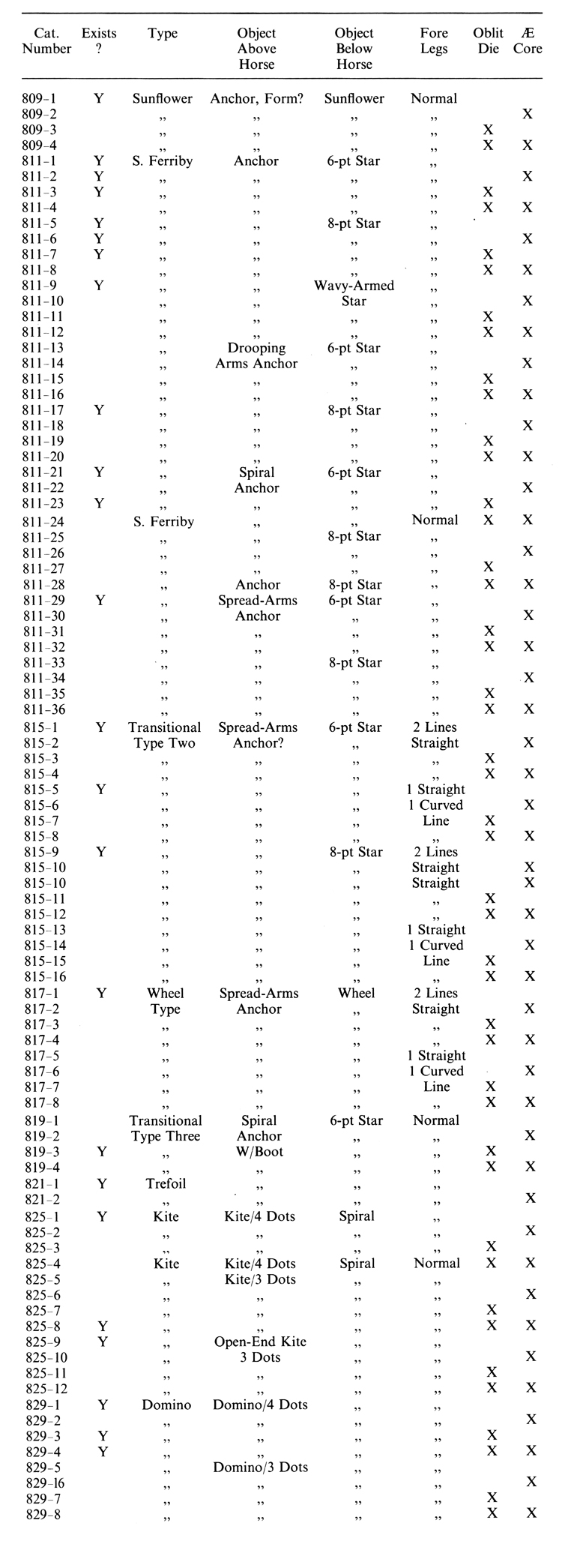
Celtic Coinage of Britain
third edition
Click on coin to see hidden information
South Ferriby Type Staters
In the past, several different varieties of coins were included under the South Ferriby Type. All had a highly stylized horse on the reverse, with variations in the ornaments in the field. The series is one of bewildering complexity and to make it more understandable, the term "South Ferriby Type" is now limited to only one variety, number 811. The other varieties have been renamed, basically according to the field ornaments.
The ornaments above the horse include variations of an anchor-like object; a rectangle with dots, which is now called a domino; and a lozenge-shaped box with pellets, which is now called a kite. Below the horse appear a six- or eight-pointed star, a wavy-armed star, a sunflower, or a spiral. The upper portions of the horse's front legs are either made up of a single line (the normal type); or two lines, either both straight, or one straight and one curved.
To add to the complexity, the obverse dies were often used until they were almost completely obliterated, yielding almost-uniface varieties. Coins made of bronze cores wrapped in gold foil are known for many types and the dies from which they were struck are competently engraved.
Consequently, when all these variations are combined, a tremendous number of types may be postulated. Many of these are not known to exist today; but many do, and others will probably appear in the future. Consequently, the following catalogue section has been constructed to accommodate the potential varieties. The accompanying table gives the catalogue numbers and descriptions, along with an indication of those types known to exist today.

817 - 01 Wheel Type
ca. 45-10 B.C. Extremely Rare
Gold Stater 5.2-5.7 gms. 18 mm
Earliest Record: Roth, 1908 (South Ferriby Hoard)
OBV: Abstracted head of Apollo
Identifying points:
1) spike with one crescent, end of spike may be bent to form two-pronged hook
2) wreath: leaves inwards
REV: Disjointed horse left
Identifying points:
1) front forelegs of horse are made up of two straight lines
2) four-spoked wheel below horse
CLASSIFICATION: Corieltauvian E
Notes:
- Celtic Coin Index records still indicate rarity
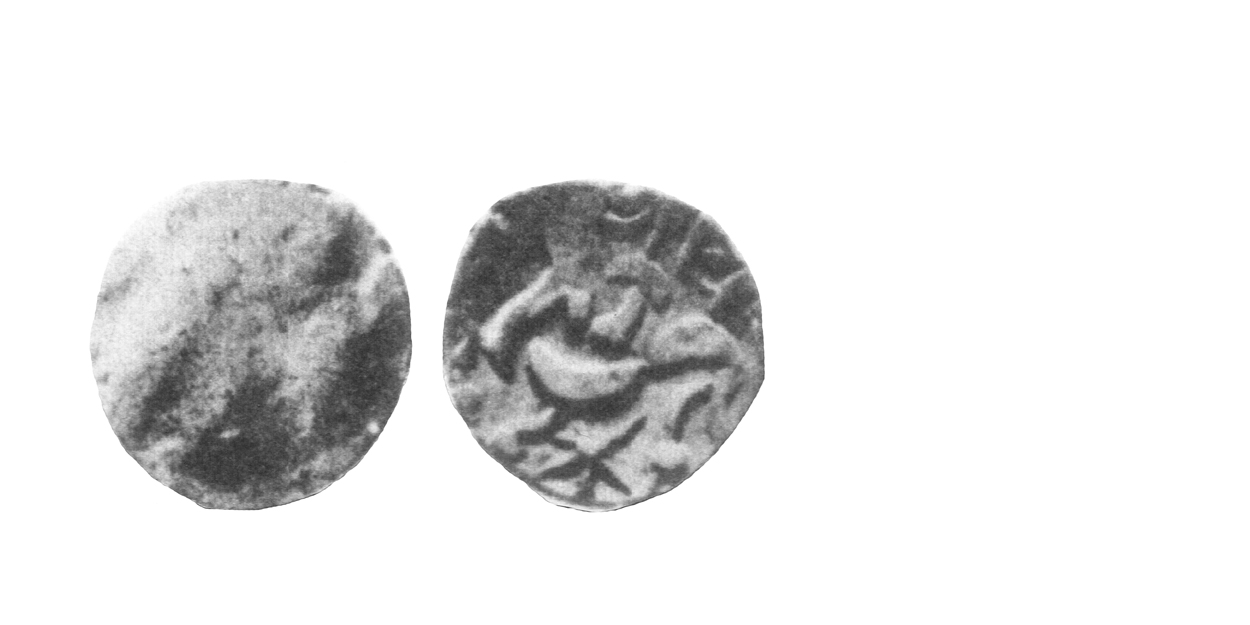
819 - 03 Transitional Type Three
ca. 45-10 B.C. Extremely Rare
Gold Stater 5.2-5.7 gms. 18 mm
Earliest Record: Roth, 1908 (South Ferriby Hoard)
OBV: Abstracted head of Apollo right
Identifying points:
1) obverse die almost obliterated
REV: Disjointed horse left
Identifying points:
1) "anchor" above horse transformed into two spirals encompassing pellets
2) boot-like object in centre of horse
3) six-pointed star below horse
CLASSIFICATION: Corieltauvian E
NOTES:
- Obverse die used until almost completely obliterated, some examples show almost a plain obverse
- Celtic Coin Index records still indicate rarity
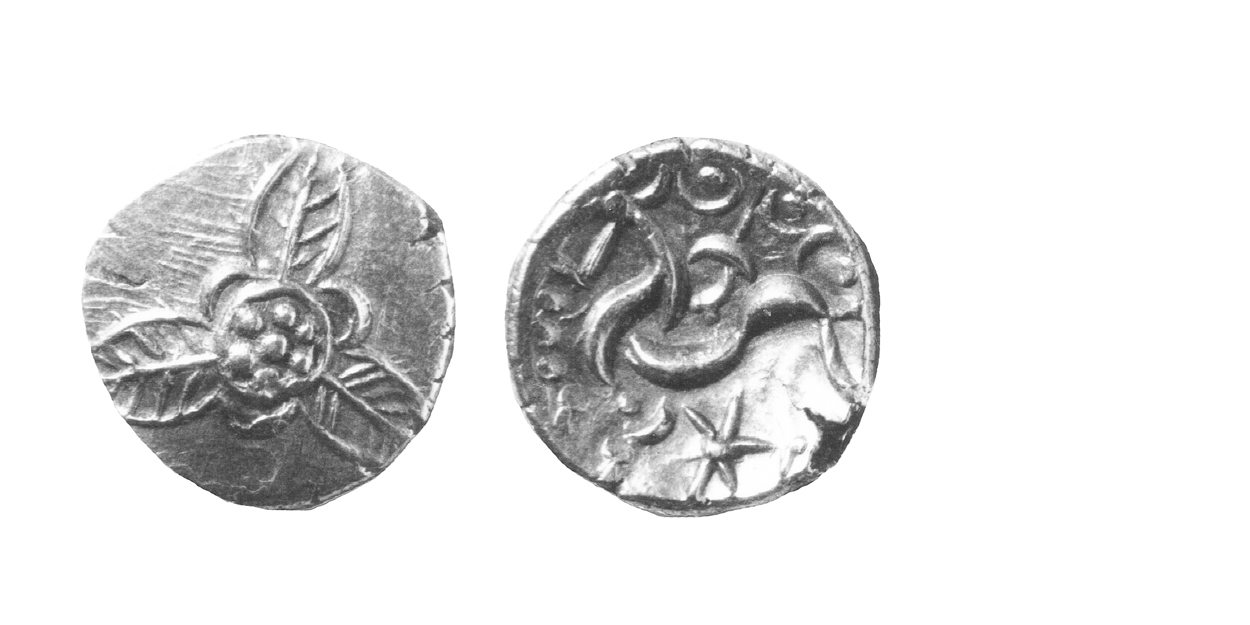
821 - 01 Trefoil Type
ca. 45-10 B.C. Extremely Rare
Gold Stater 5.2-5.7 gms. 20 mm
Earliest Record: Roth, 1909a (South Ferriby Hoard)
OBV: Elaborate trefoil
Identifying points:
1) six pellets encircling a single pellet, all within a clrcle
2) three large leaves extend from circle
3) field of coin has raised striations as if die was smoothed off with a file
REV: Disjointed horse left
Identifying points:
1) "anchor" above horse transformed into two spirals encompassing pellets
2) boot-like object in centre of horse
3) six-pointed star below horse
CLASSIFICATION: Corieltauvian F
NOTES:
- Considered to be a pattern by Roth (1909)
- One modern forgery revealed to date – see 821 - 0lF
- One of the most tempting targets for modern forgers (after Fantasy Types)
- Published metallurgical data for the Roth example now enable forgers to copy the metal content
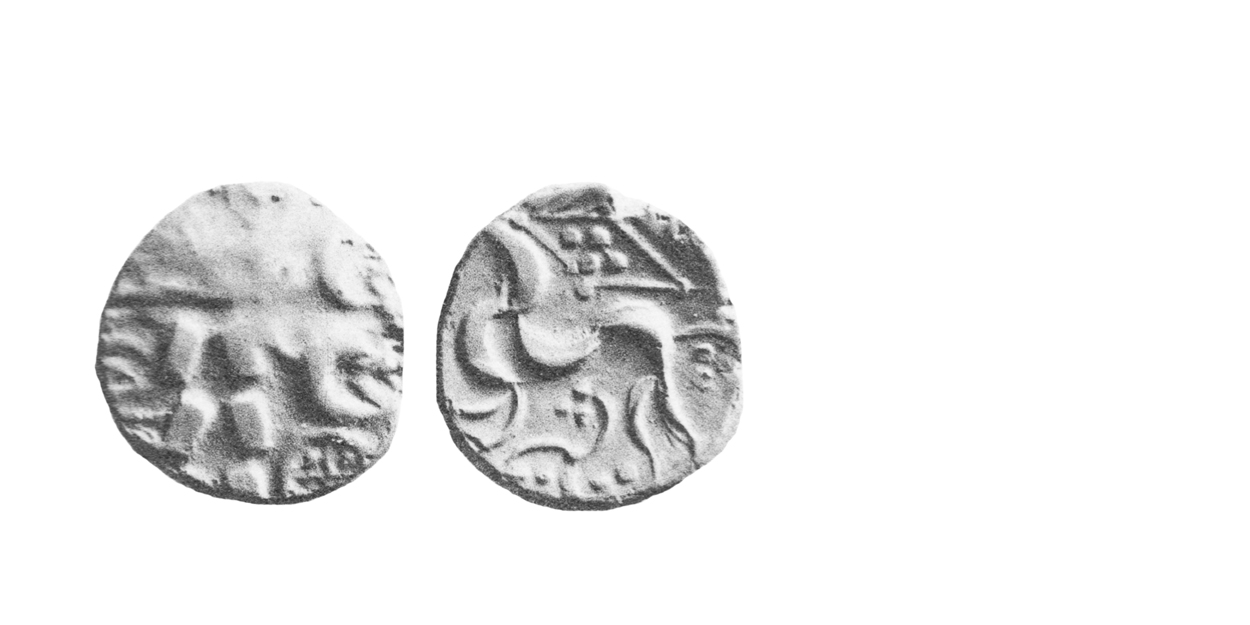
825 - 01 Kite Type
ca. 45-10 B.C. Scarce
Gold Stater 5.2-5.7 gms. 16 mm
Earliest Record: Evans, 1890
OBV: Abstracted head of Apollo right
Identifying points:
1) spike with one crescent
2) obverse die often partially obliterated
3) wreath: leaves inwards, slightly splayed
REV: Disjointed horse left
Identifying points:
1) three-armed spiral below horse
2) three pellets at end of each spiral arm
3) kite-shaped box above horse
4) four pellets in box
CLASSIFICATION: Corieltauvian G
Notes:
- Celtic Coin Index records now indicate commoner because of new finds
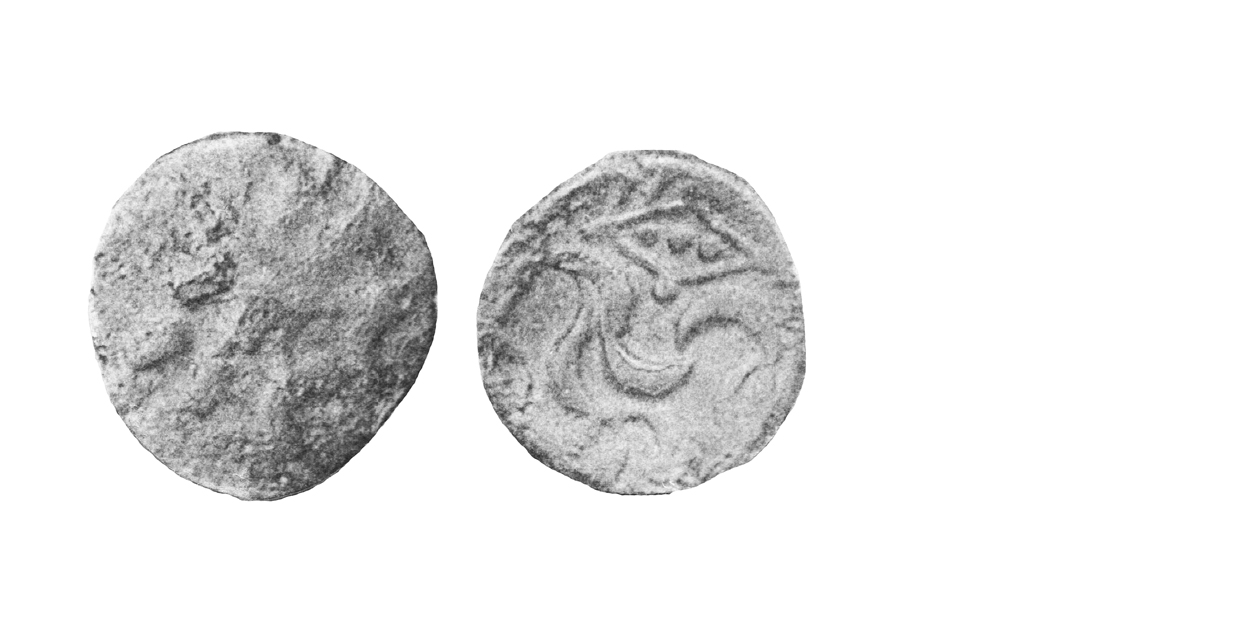
825 - 08 Kite Type
ca. 45-10 B.C. Extremely Rare
Gold/Bronze Plated Stater 19 mm
Earliest Record: Hawkes and Hull, 1947
OBV: Abstracted head of Apollo right
Identifying points:
1) obverse die almost obliterated
REV: Disjointed horse left
Identifying points:
1) kite-shaped box above horse
2) three pellets in box
CLASSIFICATION: Corieltauvian G
NOTES:
- Bronze core of a plated stater
- Ancient forgery of predicted type 825 - 07, suggesting a genuine coin of this type once existed (see Table)
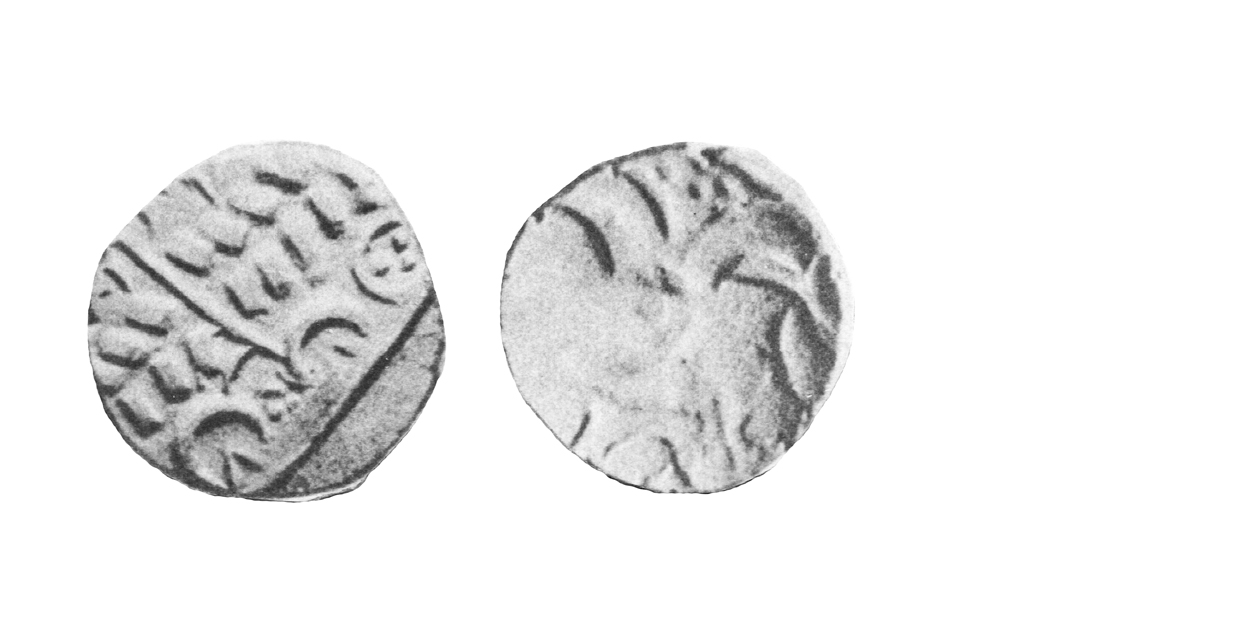
825 - 09 Kite Type
ca. 45-10 B.C. Extremely Rare
Gold Stater 5.2-5.7 gms. 18 mm
Earliest Record: Roth, 1908 (South Ferriby Hoard)
OBV: Abstracted head of Apollo right
Identifying points:
1) spike with one crescent
2) diagonal linear depression to right of curls
3) wreath: leaves upwards, highly splayed
REV: Disjointed horse left
Identifying points:
1) kite-shaped box with open ends above horse
2) four pellets in box
3) box has curved sides
CLASSIFICATION: Corieltauvian G
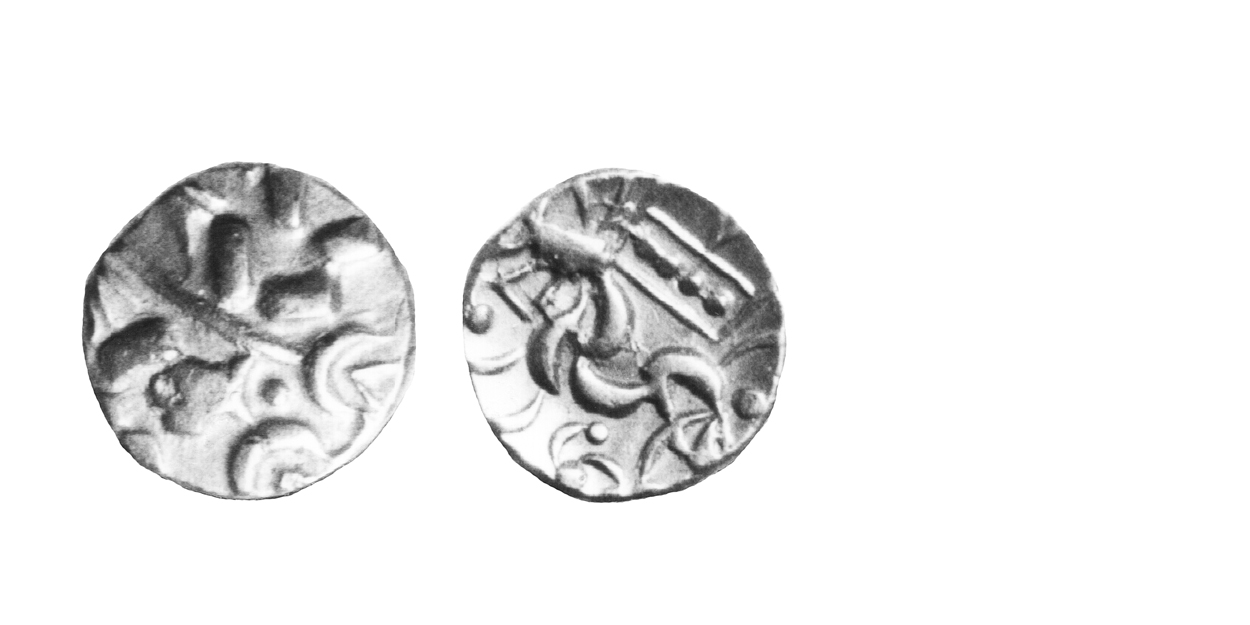
829 - 01 Domino Type
ca. 45-10 B.C. Very Rare
Gold Stater 5.2-5.7 gms. 17 mm
Earliest Record: Evans, 1890
OBV: Abstracted head of Apollo right
Identifying points:
1) spike with one crescent
2) pellet in angle formed by spike and crescent
3) wreath: leaves inwards
REV: Disjointed horse left
Identifying points:
1) multi-armed spiral below horse
2) domino-like box above horse
3) four pellets in box
CLASSIFICATION: Corieltauvian H
NOTES:
- Modern forgery exists – see 829 - 01F
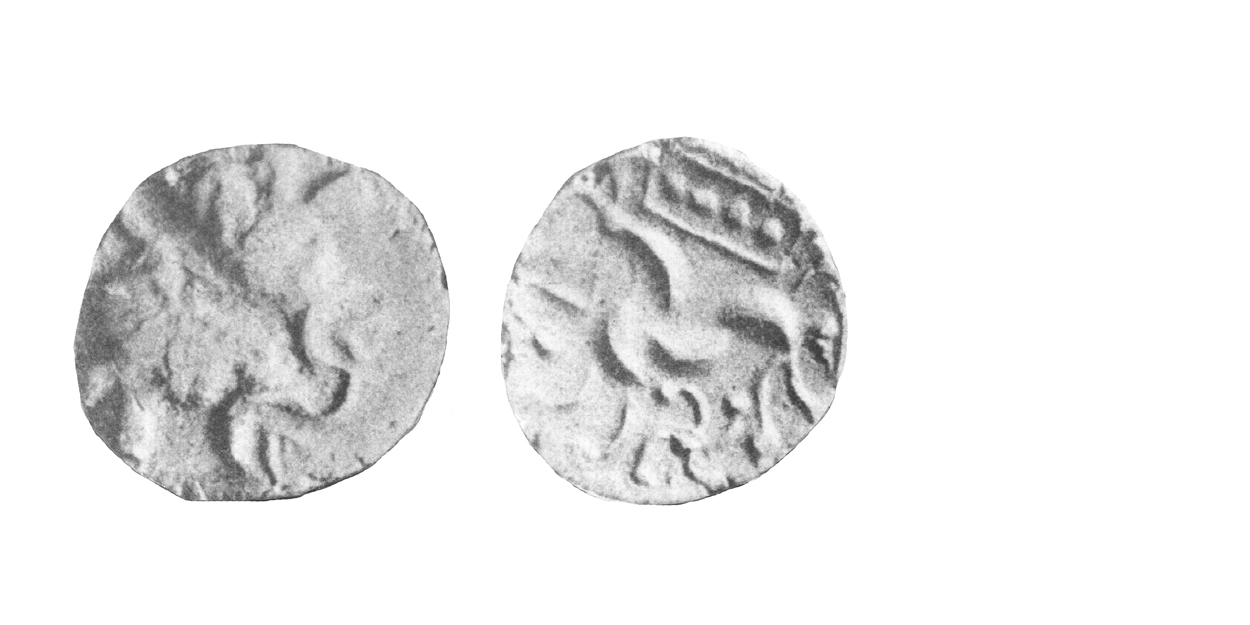
829 - 03 Domino Type
ca. 45-10 B.C. Scarce
Gold Stater 5.2-5.7 gms. 20 mm
Earliest Type: Hawkes, 1947
OBV: Abstracted head of Apollo right
Identifying points:
1) partially obliterated obverse die
REV: Disjointed horse left
Identifying points:
1) multi-armed spiral below horse
2) domino-like above horse
3) four pellets in box
CLASSIFICATION: Corieltauvian H
Notes:
- Celtic Coin Index records now indicate commoner because of new finds
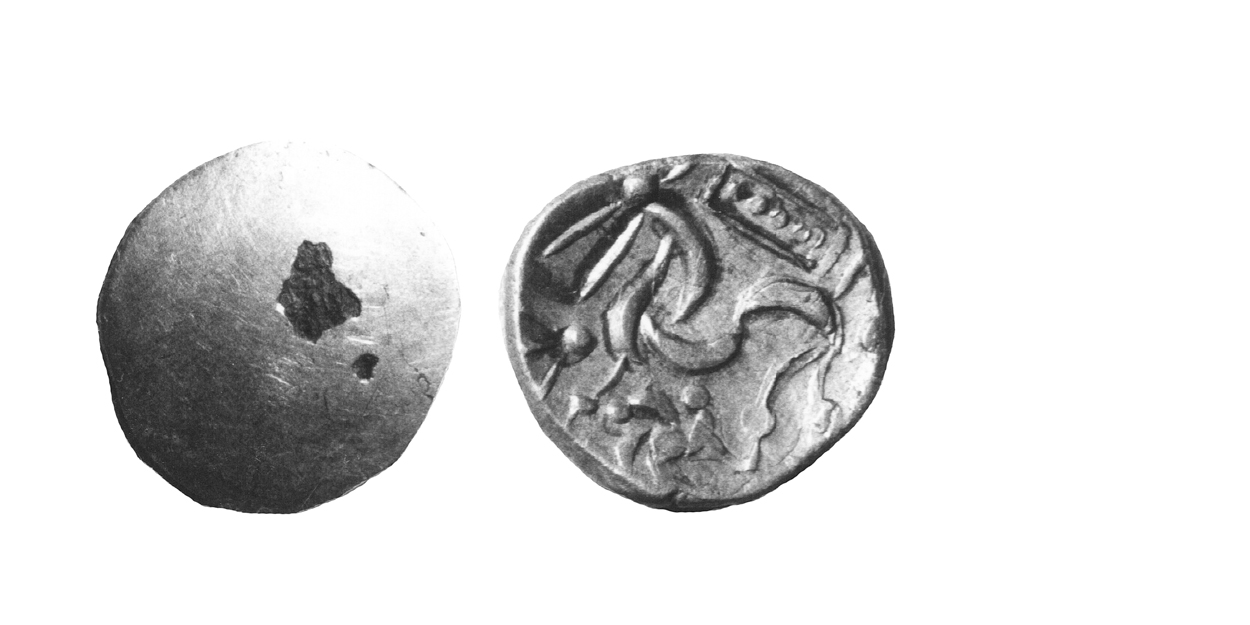
829 - 04 Domino Type
ca. 45-10 B.C. Very Rare
Gold/Bronze Plated Stater 5.2-5.7 gms. 20 mm
Earliest Record: Van Arsdell, 1989
OBV: Plain
Identifying points:
1) obverse die completely obliterated
REV: Disjointed horse left
Identifying points:
1) multi-armed spiral below horse
2) domino-like box above horse
3) four pellets in box
CLASSIFICATION: Corieltauvian H
NOTES:
- Bronze core covered in gold foil
- Ancient forgery of 829 – 03
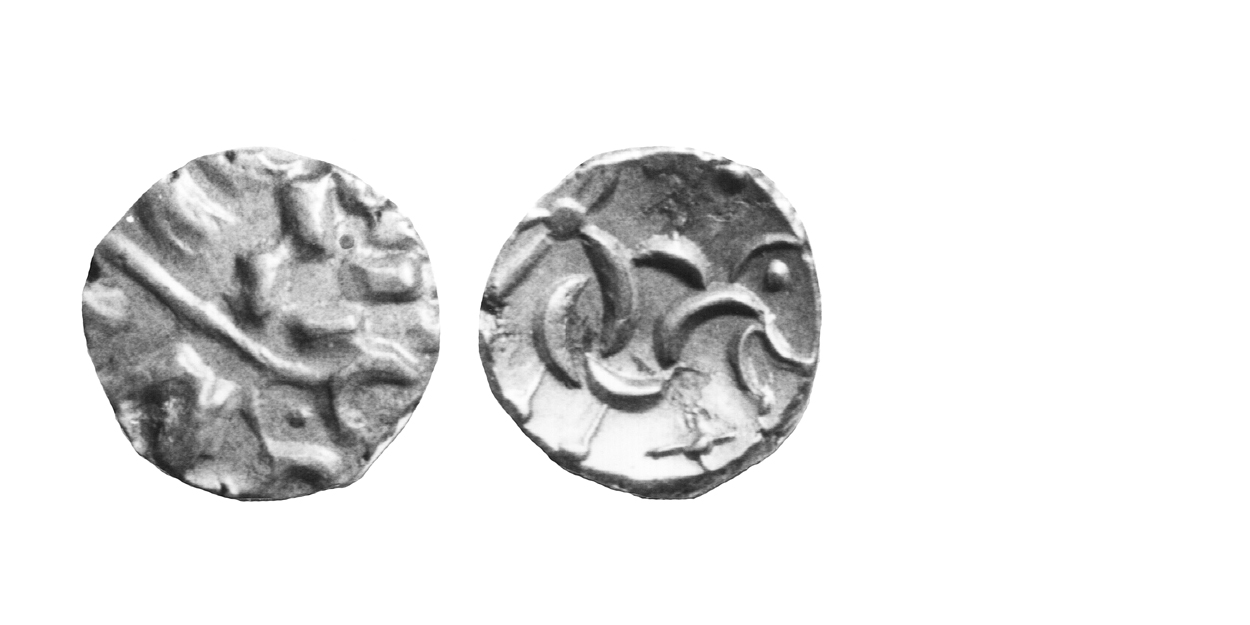
835 - 01 South Ferriby Type
ca. 45-10 B.C. Extremely Rare
Gold Stater 5.2-5.7 gms. 18 mm
Earliest Record: Roth, 1908 (South Ferriby Hoard)
OBV: Abstracted head of Apollo right
Identifying points:
1) spike with one crescent, end of spike is bent to form two-pronged hook
2) pellet in angle of hook
3) wreath: leaves inwards
REV: Disjointed horse left
Identifying points:
1) four-pointed star below horse
CLASSIFICATION: Corieltauvian D
NOTES:
- Variant type, with four-pointed star, this is believed to be a die-cutting error
- Some are in museums
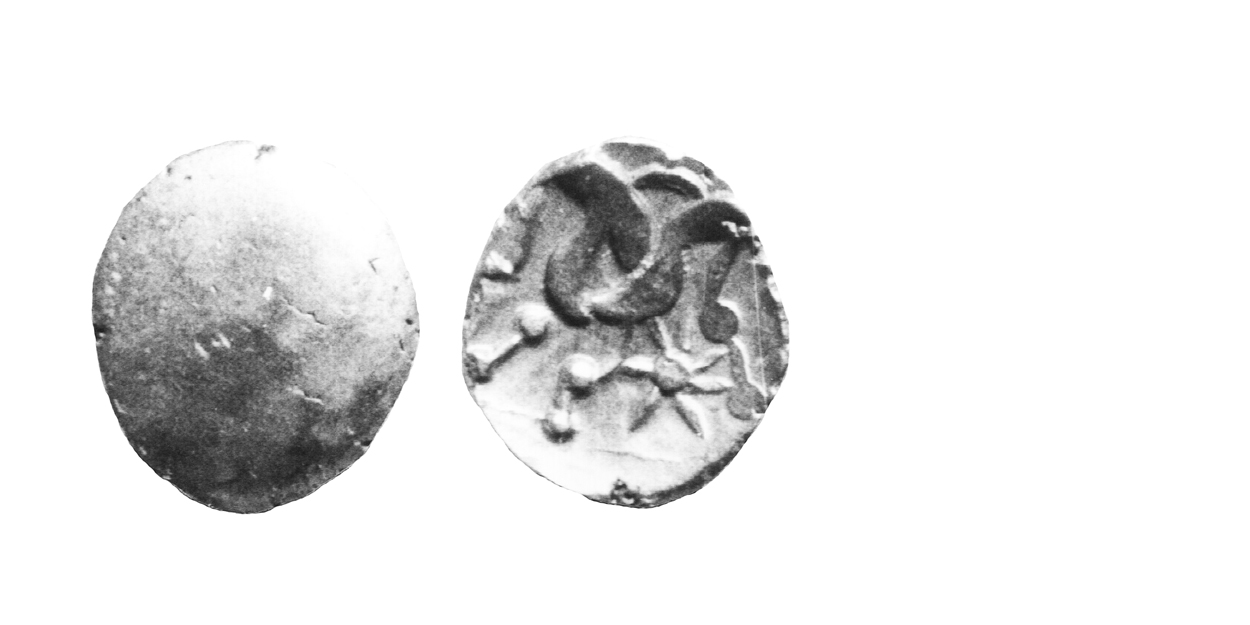
837 - 03 South Ferriby Type
ca. 45-10 B.C. Extremely Rare
Gold Stater 5.2-5.7 gms. 18 mm
Earliest Record: Roth, 1908 (South Ferriby Hoard)
OBV: Abstracted head of Apollo right
Identifying points:
1) almost obliterated obverse die
REV: Disjointed horse left
Identifying points:
1) seven-pointed star below horse
CLASSIFICATION: Corieltauvian D
NOTES:
- Variant type, with seven-pointed star, believed to be a die-cutting error
- Most are in museums
The Coinage of the Iceni
The Iceni occupied the area that is today Norfolk, Suffolk and parts of Cambridgeshire. Until the time of the Gallic War, the tribe seems economically isolated. Large Flan, Defaced Die and Abstract Design Type staters are not commonly found in Icenian territory, and presumably few were imported. Locally-made coins, the NORFOLK WOLF TYPE staters and BURY TYPE silver, were first produced late in the Gallic War. The earliest Icenian gold coinage comprises gold staters with the abstracted head of Apollo on the obverse and a disjointed wolf on the reverse. The heavy weight indicates the series began some time around the end of the war. After the war, the coins become quite debased and bronze cores of plated staters occur with some frequency. Later, a small coinage of SNETTISHAM TYPE coins were struck in gold and silver.
Apparently, extensive trading contacts developed during the war with the Trinovantes/Catuvellauni. A small number of Gallic War Type staters are found and uninscribed staters of the Trinovantes/Catuvellauni also appear. After the war, the coins of Addedomaros and Tasciovanus circulated. It is possible the Iceni relied on these imports instead of striking their own gold in volume.
About 20 B.C., the gold content of the Icenian coinage was restored with the introduction of the FRECKENHAM TYPE. Staters and quarters were struck lighter in weight to conform with the coinages of the other British tribes. The staters had a flower pattern or cross of pellets on the obverse and a Celticized horse on the reverse. Three major types occurred, described either as EARLIER and LATER, based on style and the progressive damage to one particular die linked with several others. Since all three types occurred in the Freckenham Hoard, it is likely they were contemporary.
After the war an extensive Icenian silver coinage was produced, which probably continued up to the time of the Boudiccan Rebellion. Silver units were produced to a standard weight of 1.25g. for nearly 100 years, a remarkable economic and technological achievement. There was a bewildering succession of types, subtypes and minor die varieties. These varieties have been systematically analyzed by John Talbot, and the arrangement is now reasonably certain. It appears that in any given period, three separate kinds of silver were being struck. Talbot suggests that the main Icenian mint either had two branch mints, or alternatively three workshops within a single mint. It is also possible that the different kinds of silver were either produced for different purposes, or perhaps at different times within a given period. Generally, the absolute chronology needs additional work. The chronology used here makes use of the work reported in John Talbot and Ian Leins's 2010 paper in The British Numismatic Journal.
The FRECKENHAM TYPE disappeared by 20 A.D. and the uninscribed silver coins were superseded by the dynastic. Very few inscribed gold coins are known. It is possible the gold coinage was minimal and the Iceni used silver coins augmented with Trinovantian/Catuvellaunian gold after 20 A.D. The Icenian dynastic period is largely one of a prolific silver coinage, beginning with the addition of an inscriptions to the CRESCENT TYPE and the introduction of the EMBLEM TYPE.
Most of the major types are listed here, but some of the minor issues need to be added. The dating of the various issues is controversial and that offered is somewhat arbitrary, based on die studies, typological sequences and analyses of coin hoards deposited around the rebellion of 61 A.D.
